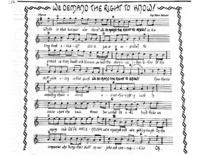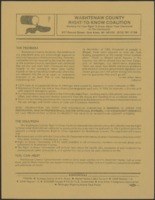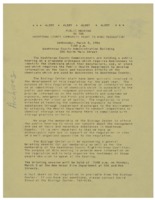Giving Workers and Communities the Right to Know
"The release of contaminants in the workplace environment through spills, dumping, discharges, or final product use have made it inevitable that community members would join with workers to demand the right to know." - Ecology Report, Vol. 17, No. 4, June 1985.
"We Demand the Right to Know!"
Before the passage of right-to-know legislation in the 1980s, Michigan companies did not have an obligation to report the presence or use of many toxic chemicals. Consequently, residents of communities where manufacturing or use occurred could remain unaware of potential sources of harm to their homes or workplaces. Emerging from concern about a lack of information about possibly dangerous chemicals, and in the wake of the Bhopal disaster in December 1984, during the 1980s activist organizations banded together to pass right-to-know laws mandating that polluting industries and businesses release information about chemical use. At the heart of the right-to-know campaigns was a hope that increased awareness of toxic threats would energize grassroots organizing, subsequently reducing the use of toxics use, and resulting in increased safety for residents and workers.
"People realized, 'We don't have the right-to-know what chemicals are in the big factories that are next to our homes, what chemicals are being trained or trucked through our communities. We don't know their identity. We don't know what kind of harm they cause. We don't know how to clean them up. We don't know if they catch fire, what kind of contamination they cause.'" - Interview with Tracey Easthope, July 2019.
In the mid-1980s, a group of labor activists formed a coalition to advocate for a state right-to-know law focused on worker exposure. Charles Griffith, a U-M graduate student at the time, became involved in the state right-to-know campaign during its infancy. By studying how grassroots organizations in other states organized their own advocacy, Griffith came up with the idea to supplement the statewide effort with a local right-to-know campaign focused on raising community awareness.
Community Right-to-Know Campaign
As the chances of the state legislation becoming law began to look less straightforward in 1985, Griffith urged the Ecology Center to become a leader in the campaign to pass ordinances on a local level requiring the disclosure of information about toxic chemicals in Washtenaw County. To do so, the Ecology Center created a coalition with firefighters, autoworkers, public health officials, environmentalists, and other local supporters. The Washtenaw County Right-to-Know Coalition became a model for right-to-know coalition building across the state, showing the strength that could be derived from bringing together a wide range of community organizations together around a single issue like toxics.
In 1985, the Washtenaw County Health Department and the Right-to-Know Task Force developed a Washtenaw County Right-to-Know Ordinance. The Ecology Center reviewed the regulation and decided to support its passage. The new guidelines proposed that:
1. Businesses put the names of hazardous substances that they store, transport, manufacture, or emit on file with the County Health Department
2. Disclosed information could be readily available to all community members concerned about toxic substances in Washtenaw County
3. Facts about the health risks, symptoms of and treatment for exposures, safety measures, and instructions for fires caused by certain chemicals would also be listed.
In early 1986, before the County Commissioners voted on the ordinance, the county scheduled a public hearing. Members of the right-to-know coalition knew the bill would face harsh criticism from chemical manufacturers, the Farm Bureau, and the State Chamber of Commerce. The Ecology Center activated its network to ensure that citizens of Washtenaw County and proponents of the bill would be present and prepared to fight for its adoption. Following the hearing and split along partisan lines, the commissioners approved right-to-know legislation on April 2, 1986.
After 18 months of hard work from many grassroots organizations, the county ordinance represented a victory for the Ecology Center and its partners who continued to empower community organizations across the state of Michigan to fight for similar ordinances in their local communities. The EC continued to offer technical assistance to communities about how to reduce the presence of toxins. Five days after Washtenaw County approved its right-to-know legislation the state passed its own package of three bills. The first provided access to chemical information for workers whose jobs involved routine use of hazardous chemicals, a second allowed fire department chiefs to request information about chemicals in the department's coverage area, and the last made it possible for a county resident to request a list of hazardous chemicals from any concern that employed workers within the county.



